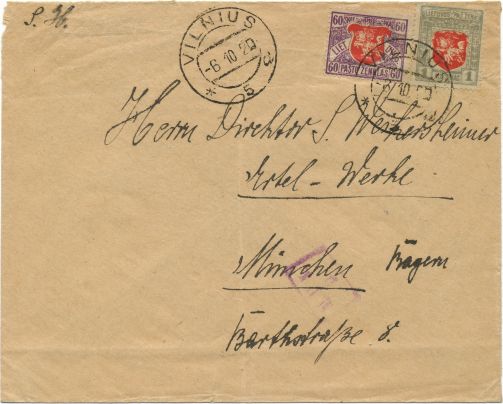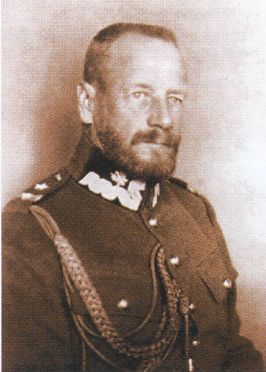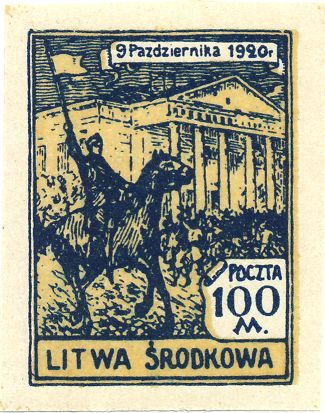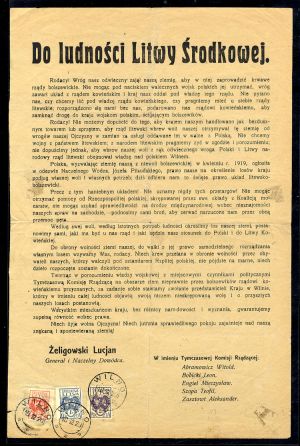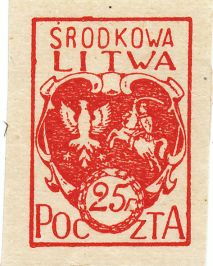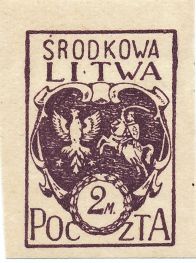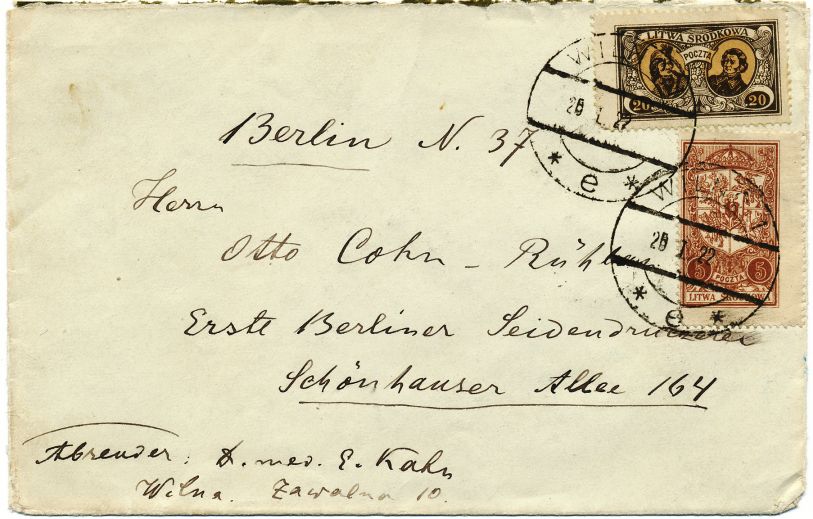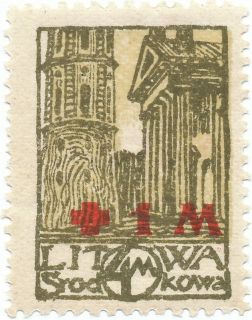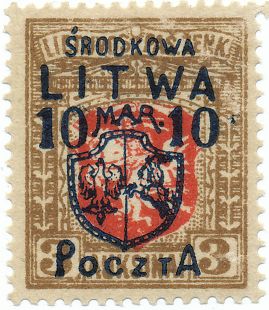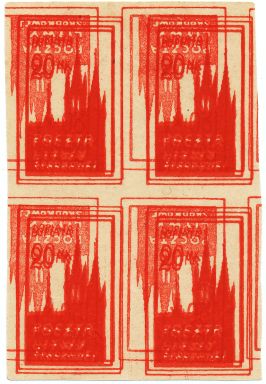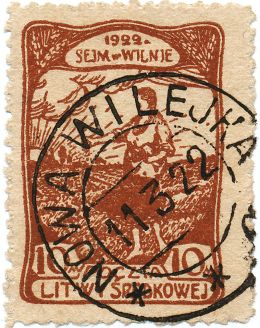Lithuania
-
Royal Polish Post
-
Imperial Russian Post
-
German Occupation / Ob. Ost
-
Independent Republic of Lithuania
-
Central Lithuania
This collecting area, formerly a stepchild of Baltic and Polish philately, has been rescued from oblivion through the work of Gerhard Hahne (). Intensive research by Polish, Lithuanian, German and US philatelists has meanwhile turned Central Lithuania into a serious collecting area, which can still be completed today without much effort and offers many interesting specialities.
Political history
The short-lived Stamp Land of Central Lithuania, Litwa rodkowa in Polish, came into being in the course of the reorganisation of Europe after the end of the First World War. For centuries the seat of government and heartland of the Grand Duchy of Lithuania, the "Vilnius Region" became a bone of contention between the newly emerging nation states of Lithuania and Poland at the end of the First World War. The relationship between the countries was shattered due to reciprocal claims to the areas around Vilnius, Grodno, Suwalki and Lida. The League of Nations turned out to be too weak to find a solution appropriate to the peoples' right to self-determination. Consequently, the ruling power in each case asserted its interests by force of arms and froze the conflict without resolving it.

Map Languages and National Movements in the 19th Century
(Excerpt; Source: Information on Political Education 225 (1989) p. III)Lithuanians, Poles, Jews, Germans and Russians lived in the areas disputed between Lithuania and Poland.
In the years during and after the First World War, the masters in Wilna (Lithuanian Vilnius, Polish Wilno) changed several times:
Year Date Event 1915 18.10. German troops conquer the city. 1919 4.–5.1. Capital of Lithuania under Lithuanian sovereignty 5./6.1. Occupied by the Red Army in the course of the Soviet-Polish war (until 19.4.). The Lithuanian government has to relocate to Kaunas. 19.4. Polish occupied (until 14.7.1920) 1920 15.7.–25.8. Occupation by the Red Army 25.8. Handover of the city from the Red Army to Lithuania, Lithuanian sovereignty until 8.10.1920 9.10. Occupation by troops of the Polish General Lucjan eligowski 10.10. Proclamation of the State of "Central Lithuania / Litva rodkowa 20.10. The (Polish) military administration takes over the postal service. 1922 24.3. Attachment of Central Lithuania to Poland. No postal traffic between Lithuania and Poland until 1938. 1939 17.9. Soviet troops occupy the eastern part of Poland, including the Vilnius region. 10.10. The Soviet Union hands over the Vilnius region to Lithuania; Vilnius is once again the capital of Lithuania. 1940 14.6. Invasion of Lithuania by Soviet troops 3.8. Integration into the Soviet Union as the Lithuanian SSR
Postal history
The area around Vilnius/Wilno/Wilna is referred to in the following as the " Vilnius area". Its borders changed several times over the years as a result of several armistices and treaties. The map shown here covers the area that Lithuania received from the Soviet Union in 1939. The postal locations are of interest to stamp collectors and examiners:
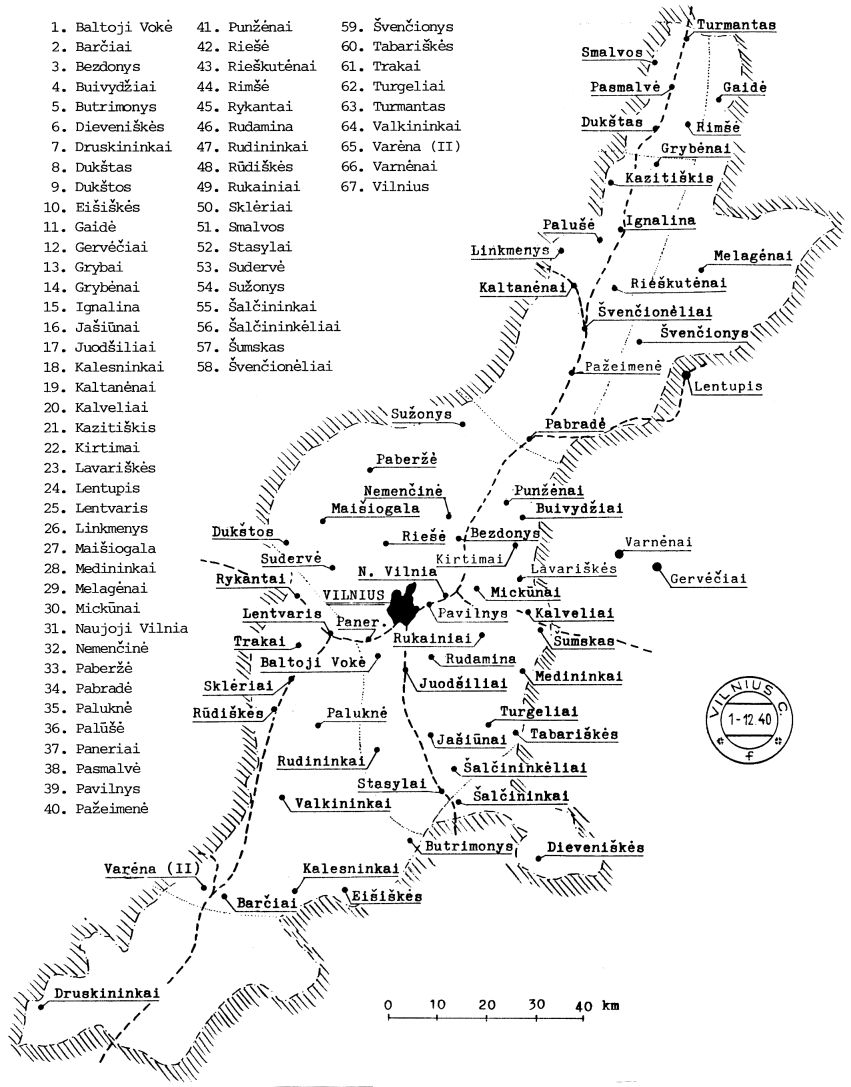
Map The Vilnius/Wilno/Wilna Area with Post Offices
(Source: Fugalevich/Bechstedt, Handbuch der Poststempel in Litauen, p. 308)
Forerunners
Polish and Lithuanian postal items from the period between January 4, 1919 and October 9, 1920 can be considered as forerunners of Central Lithuania. These are extremely rare. The same applies to an even greater extent to postal items from the periods of Soviet occupation during the Polish-Soviet War of 1919/20.
The State of Central Lithuania / Litwa rodkowa
When, at the instigation of the League of Nations, the area around Vilnius was awarded to Lithuania in the Suwalki Peace Treaty from October 8, 1920, Polish "volunteer units" under General Lucjan eligowski marched into the city of Vilnius and the area surrounding it on October 9.
The provisional government appointed by General eligowski on October 10 proclaimed the "independent" state of "Central Lithuania / Litva rodkowa" on October 12, 1920, whose parliament voted for annexation to Poland on February 20, 1922. This was accomplished on 16 April 1922. Lithuania's stamps lost their validity as postage stamps on April 18, 1922.
From then until the renewed occupation of the area by Soviet troops in September 1939, only Polish postage stamps were used, and from October 10, 1939, Lithuanian postage stamps were used again.
On 20 October 1920, the independent postal administration of Central Lithuania began its activities with the issue of the first stamp series. Within two years it had 47 main numbers in the Michel catalogue.
Their main purpose was to gain foreign currency. Almost all available paper was printed and the stamps were issued cut and perforated at the same time, except for one series.
The few genuinely used postal items often look shabby due to the circumstances of the time and are rare and expensive.
Most of the stamps are cancelled to order and do not deserve the title "artistically valuable".
This is probably one of the reasons why the field of collecting had a shadowy existence for a long time.
After the hasty evacuation of Vilnius by the Lithuanian administration on 9 October 1920, remnants of the 3rd and 4th Berlin issues remained. A stamp dealer initiated their overprinting, creating the only expensive series in Central Lithuania.
Their highest value of 10 marks, overprinted on stamps of 1 Auksinas, 3 and 5 Auksinai, are today the key values of a collection of Central Lithuania, although they did not appear at the post office counter.
There are essays and waste paper (print rejects) of almost all stamps, both often offered in auctions and quite useful as illustration of a collection:
Since the postmarks of post towns from the Vilnius area outside Vilnius are very rare, but can still be found on inexpensive pieces, an interesting collecting area has arisen from this.
The Warwiszki Issues
In March 1923, the League of Nations divided the formerly demilitarised zone of Warwiszki between Poland and Lithuania. Warwiszki was supposed to fall to Lithuania, which led to an uprising of Polish irregulars who completely burned down the town on March 27.
The leader of the uprising, Chmura, arranged the issue of overprint stamps in denominations of 50, 100 and 200 Polish Marks on Poland Michel Nos. 172-174 to pay the charges for carrying the mail under tight wraps to the nearest Polish post office in Sopoćkinie.
Used stamps must therefore always bear the black postmark of Sopockinie in addition to the violet postmark of Warwiszki. So far, fewer than five such covers have become known.

Stamps of the Warwiszki issue, see also https://huylmans.de/pruefgebiete-unterseite/sammelgebiet-polnische-besetzung-warwiszki.html
Outlook
After the entry of Central Lithuania into the Polish state on March 24, 1922, Polish stamps were used:

Polish postal stationery, additionally franked with a stamp commemorating the death of the state founder Józef Piłsudski, who came from Vilnius.
With the transfer of the Vilnius region by the Soviet Union to Lithuania on October 10, 1939, Lithuanian postage stamps were used again.
Lithuanian sovereignty ended again with the invasion of Lithuania by the Red Army on June 14, 1940. The postal administration of the Lithuanian SSR was an integral part of the postal administration of the USSR.
-
Memel Area / Klaipėda
-
Soviet Occupation
-
German Occupation / Ostland
-
Camp Mail / Lithuanians in Exile
-
Independent Republic of Lithuania (restored)
-
Private Mail in Lithuania



